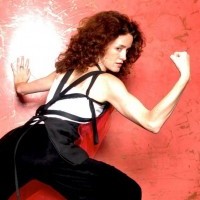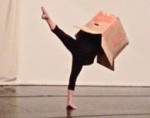
(A) Moving Work
by Carolyn Merritt
What do you do for a living? Would a job title suffice to explain it? RealLivePeople(in)Motion Director/ Choreographer Gina Hoch-Stall interviewed 25 Philadelphians about their relationship to work to construct The Jobs Project, an hour-long piece for a cast of six, including herself, Molly Jackson, David Konyk, Sara Nye, Mason Rosenthal, and Hedy Wyland. She selected excerpts from the transcripts for the sound score (designed by Ilan Isakov), and the dancers further discussed the topic and explored the themes, the cast’s and the interviewee’s words through movement. As Hoch-Stall discovered and the work explores, that simplest of dinner party questions can yield surprising results.
The Jobs Project is complex; an ambitious undertaking for a relatively young company. Divided into at least twenty different scenes involving nearly every possible permutation of dancers, its movement ranges from tightly choreographed and lush unison phrases to contact partnering to task-oriented gestures that evade strict pedestrianism, all set to a soft electronic sound score that weaves in interview excerpts.
The text is rich. We get a sense for both the multitude of tasks involved in various jobs, as well as informants’ concerns regarding work-life balance, delineating job from career/ work from vocation, and the relation between work and identity. Representing positions as diverse as trash truck driver, archaeologist, librarian, gogo dancer, hair stylist, and more, their words reveal the absurdity of pigeonholing.
Hoch-Stall is one of the city’s strongest dancers. Her movement, so capacious, seems to have no beginning and no end. This is matched by a streamlined precision, utterly absent of extraneous elements. It is a joy to watch her do just about anything on stage, though these qualities emerge most in the unison sections of the work. Here, her luscious phrasing is replete with arabesque extensions, turning attitude leaps that propel the dancers from the ground and back silently, circular suspensions that release and fall sequentially, then rebound instantaneously. These sections could be anatomy teaching moments, lessons in the subtle interplay between vertebral stability and fragility.
This strength may occasionally be a weakness, however. In a conversation after the show, Hoch-Stall underscored the company’s “audience-oriented” approach to dance, emphasizing RLPiM’s care for the audience via two points: 1) the work’s duration, arguing that an artist should be able to say something in 60 minutes or less; and 2) the inclusion of unison movement set to music as a break from the layered sections (of various, often unsynchronized movements to interviewees’ words). While I appreciated her point in the aftermath–that the “pure dance” functioned as a palette cleanser, helping us to digest the text–this made for a disjointed experience in the moment. I kept trying to link the unison sections to the larger themes and words of the interviewees; the movements themselves were lovely, but the connection often unclear.
If each of the dancers is not necessarily as exceptional as Hoch-Stall, together they form a powerful ensemble. Equally at home upside down and right side up–headspins, handstands, and inversions abound–they are seamless improvisers, skilled in partnering. Particularly fulfilling are repetitive gestural phrases that evoke recognizable tasks–mouse-clicking, counting, cranking, pouring, filing–only to evolve and transcend the literal, and physical manipulations that make bodies object and concept, as when Jackson lies across Konyk’s lap, extending horizontally like the arm of a clock, reckoning time in billable units. The opening of the piece, when Wyland and Hoch-Stall circle the stage in office chairs to the interviewees’ words, is oddly touching. Their faces disoriented, as if reiterating where the work begins–in a space of unknown, traversed by listening–they honor the voices they embody.
The piece also features live conversations with the dancers. Playing the interviewer, Mason Rosenthal invites each dancer to discuss some aspect of his or her work life. From the first exchange, when he interrupts Konyk’s Keatonesque duet with a rolling chair, Rosenthal sprints and slides across the room in pursuit of his informants, each contorting him or herself in relation to the other and the microphone. This table-turning device is played for humor and changes little. It is a clever take on positioning oneself, but in going for laughs from the start, limits Rosenthal to quirky while somewhat diminishing the art of interviewing.
Still, there are striking revelations. All perform various jobs, some related and others unrelated to their dance careers, though Konyk’s confusion–over distinguishing his jobs from his career, and defining each as time goes by–is the most poignant, perhaps because he is the eldest. We become witness to his particular liminality, both generational and of this time. When he confesses to “not know” what the future holds, I feel relief and fear at once. I remember the ambivalent valedictorian from Say Anything, her speech a refrain that has flashed before me at graduation upon graduation upon graduation. The future remains scary.
The weekend of the show, The New York Times featured reader input on the country’s changing job market. More than one questioned whether the link between self-worth and employment, so long essential to American identity, is not permanently ruptured:
“How, ultimately, do we define what it means to be a productive member of society when there are no longer enough jobs for people?”*
Interestingly, of the 25 people that Hoch-Stall interviewed for The Jobs Project, only one is unemployed. At 4%, that is lower than both the national and Philadelphia averages–7.5% and 10%. This is not to fault RLPiM for not creating the piece I want to see, but to highlight the depth of the topic they engage, and to question whether leaving it unplumbed is not somewhat irresponsible. It is a worthy topic because it is so timely, and because, as Hoch-Stall herself suggests onstage, dance conveys information in a unique way. If all art does this, dance–the most kinesthetic of disciplines–has the potential to do so most viscerally. Dancers have famously taken on such meaty topics as AIDS, the Depression, incest, war, identity politics, and much more. I hope RLPiM continues to probe the meanings of work and its translation into movement, because their project feels unfinished, yet it is an infinitely rich one.
By Carolyn Merritt
May 30, 2013










